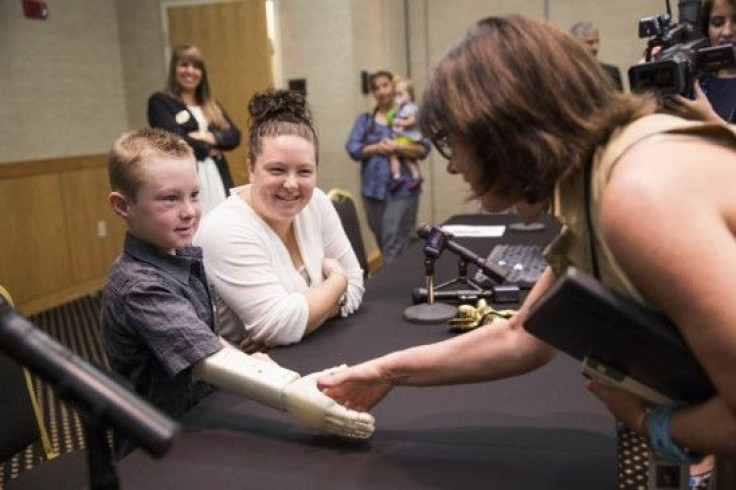6-Year-Old Gets 3D-Printed Prosthetic Arm; Hugs His Mom For The First Time With Both Arms

After being born with a limb deficiency that left him without the lower part of his right arm, 6-year-old Alex Pring yearned for the activities that are normal for most children, including catching a ball, climbing a tree, and hugging his mom with both arms. Thanks to specialists from the University of Central Florida, Alex is getting his chance to live his life with both arms via a 3D-printed prosthetic arm that is capable of opening and closing the hand through muscle movement in the boy’s upper arm.
“My mother taught us that we’re supposed to help change the world,” UCF engineering doctoral student Albert Manero said in a statement. “We’re supposed to help make it better. That’s why we did it. The look on Alex’s face when he used it for the first time was priceless.”
Manero holds a place in his heart for people with a missing or deformed limb, having grown up with a friend that was missing fingers. He got in touch with Alex’s family through the online network for volunteer engineers, 3D enthusiasts, occupational therapists, students, inventors, and professors, e-NABLE. While 3D-printed prosthetic limbs for adults have become relatively easy to develop, the same cannot be said for children. Finding components small enough to fit a child is largely problematic, and insurance companies tend to shy away from the costs because the child will eventually outgrow the prosthetic limb.
In spite of the uphill battle, Manero was determined to see that Alex’s dream of a normal childhood was fulfilled. To help design a prosthetic arm with a functioning elbow that could facilitate hand movement, Manero recruited UCF aerospace engineering undergraduate Mateo Alvarez and other experts in the fields of electrical, mechanical, and civil engineering. The team also received supplies from Stratasys, one of America’s largest 3D printer manufacturers. For seven weeks, the UCF research team devoted the majority of their time into developing a functioning prototype that would fits Alex’s dimensions. On July 25, it was time to see if the $350 prosthetic arm would fit Alex’s needs.
“He learned pretty fast,” Manero said. “The first thing he did when he could actually control it a little bit was hug his mother. He said it was their first real hug. There wasn’t a dry eye in the room. We’ve already heard from another family who needs an arm. We’re committed to helping who we can and I’ll be working with my team even when in Germany. I think 3D printing is revolutionizing our world in many ways. I believe changing the world of prosthetics is very real. There’s no reason why this approach shouldn’t work on adults, too.”
Manero and his colleagues plan to upload the blueprints for their child-size prosthetic arm and hand designs on to the Internet for open access. Anyone with a 3D printer will be able replicate the prototype and fit children with missing limbs. According the Centers for Disease Control and Prevention, four out of every 10,000 babies are born with upper limb reductions each year. For Alex, the thought of growing up with two arms is enough to put an ear-to-ear smile on his face.
“When he hugged me with two hands, he just didn’t let go,” said Alyson Pring, Alex’s mother. “It was amazing. I think this arm will reinforce our ‘you can do anything you set your mind to’ attitude. I think it will help his confidence, so he can see future possibilities and make them seem all the more reachable for him.”



























